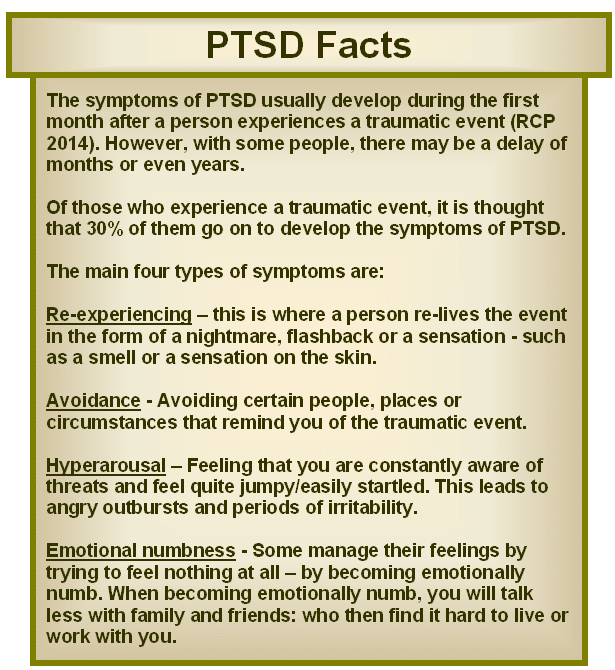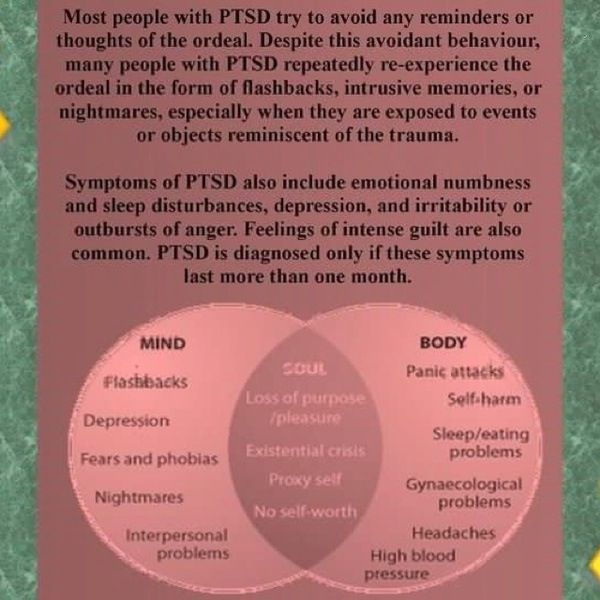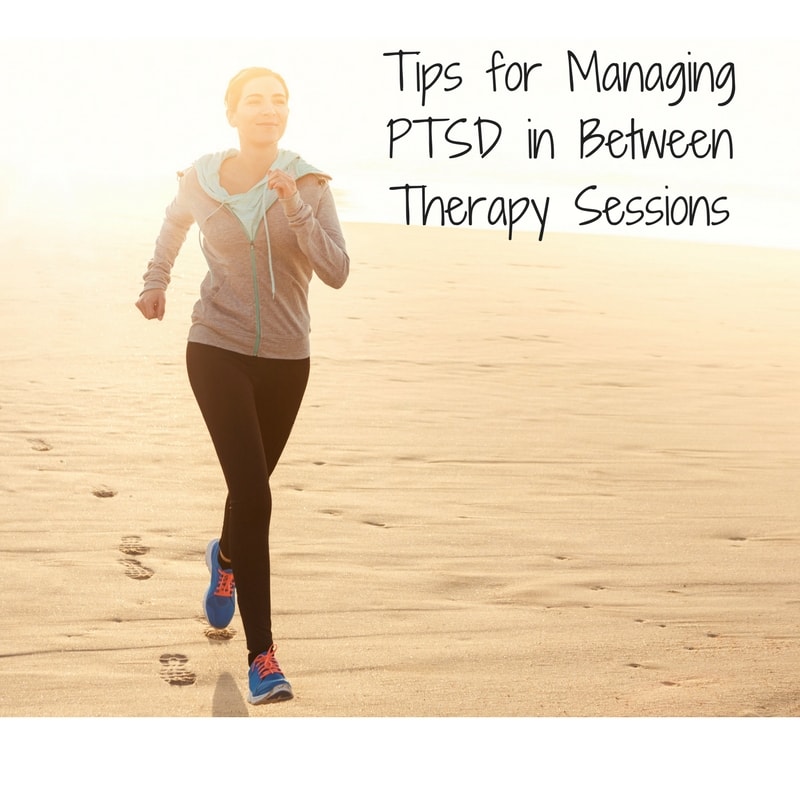Avoidance And Emotional Numbing
Trying to avoid being reminded of the traumatic event is another key symptom of PTSD. This usually means avoiding certain people or places that remind you of the trauma, or avoiding talking to anyone about your experience.
Many people with PTSD try to push memories of the event out of their mind, often distracting themselves with work or hobbies.
Some people attempt to deal with their feelings by trying not to feel anything at all. This is known as emotional numbing. This can lead to the person becoming isolated and withdrawn, and they may also give up pursuing activities they used to enjoy.
Support Is Important For Recovery
Many people experience some of the symptoms of PTSD in the first two weeks after a traumatic event, but most recover with the help of family and friends. For this reason, for a diagnosis of PTSD is not made until a month after the event. Treatment does not usually start for at least two or more weeks after a traumatic experience. However if the event is very distressing and emotions and reactions are intense, it is advisable to seek help as early as possible to understand what is happening and help recovery to start.
It is important during the first few days and weeks after a traumatic event to get whatever help is needed. This may include accessing information, people and resources that can help you to recover. Support from family and friends may be all that is needed. Otherwise, a doctor is the best place to start to get further help.
Arousal And Reactivity Symptoms
- Having difficulty falling asleep or staying asleep
- Feeling irritable and having angry or aggressive outbursts
- Engaging in risky, reckless, or destructive behavior
Arousal symptoms are often presentthey can lead to feelings of stress and anger and may interfere with parts of daily life, such as sleeping, eating, or concentrating.
Don’t Miss: What Can I Claim For Va Disability
Cognitive Behavioural Therapy For Post
Cognitive Behavioural Therapy or CBT is considered to be one of the leading psychological treatments for post-traumatic stress. All of our online programs use CBT strategies to help ease symptoms. Click below to see if CBT can help you tackle your symptoms to improve the way you feel.
Strategies for Managing Post-Traumatic Stress
Relaxation Strategies
People with PTSD often feel stressed, nauseous, tense, and irritable. This is generally because the traumatic thing they experienced has made them feel vulnerable to danger their mind feels like it needs to be on high alertat all times. Relaxation strategies can help reduce the physical symptoms of stress and help people with PTSD start to feel safe again. These can be formal therapeutic strategies, like progressive muscle relaxation or deep breathing, or the things that people normally do to relax, like yoga, aromatherapy, or having a warm bath.
Exposure Therapy
Cognitive Strategies
Coping with Symptoms of PTSD
Its generally recommended that people with PTSD seek professional help. However, some of the below strategies may help you manage some PTSD symptoms.
Cognition And Mood Symptoms

- Trouble remembering key features of the traumatic event
- Negative thoughts about oneself or the world
- Distorted thoughts about the event that cause feelings of blame
- Ongoing negative emotions, such as fear, anger, guilt, or shame
- Loss of interest in previous activities
- Feelings of social isolation
- Difficulty feeling positive emotions, such as happiness or satisfaction
Cognition and mood symptoms can begin or worsen after the traumatic event and can lead a person to feel detached from friends or family members.
You May Like: Lubbock Tx Social Security Office
Getting Help For Ptsd
Nobody can snap out of PTSD. Getting better takes professional help, time and effort. PTSD is treatable and usually requires treatment from a mental health professional.
The sooner a person is treated for PTSD, the better. Early treatment will help the PTSD from becoming ingrained and persistent for a long time. If left untreated, PTSD can become a chronic disabling mental health disorder.
It is very common to have PTSD at the same time as another mental health problem. Depression, alcohol or substance abuse problems, panic disorder, and other anxiety disorders often occur along with PTSD. The best treatment results occur when both PTSD and the other problems are treated together rather than one after the other.
What Is Chronic Ptsd
Chronic PTSD is a type of post-traumatic stress disorder that can occur after someone experiences a traumatic event. Unlike regular PTSD, chronic PTSD lasts for months or years after the event has occurred. This can lead to problems with work, relationships, and everyday activities.
This condition is simply described as having PTSD that lasts for more than three months after the event. However, this doesnt mean that the symptoms will go away after three months. For some people, the symptoms may lessen over time, but they can still have a major impact on day-to-day life.
Therefore, if you are struggling with PTSD, it is important to seek treatment as soon as possible. There are many effective treatments available, including therapy and medication. With the right treatment, you can manage your symptoms and live a fulfilling life.
Recommended Reading: What Medical Conditions Qualify For Social Security Disability
What Are The Symptoms Of Ptsd
PTSD doesn’t look the same in every person that is diagnosed. Some people experience symptoms quickly after experiencing a traumatic event. But for others, symptoms might not begin to show for years after the event has occurred. These symptoms can be split up into four different categories:
When someone experiences a traumatic event, the brain will act quickly to take the body into survival mode. This is commonly known as a state of fight or flight.
The intensity of the symptoms that you experience can increase and decrease. And there may be certain things that cause your symptoms to intensify, such as a car backfire triggering symptoms for someone that was involved in a traumatic event with the sound of guns or explosions. For others, getting stuck in a traffic line bothers them to the point that anger flares and gets out of control.
Common responses to a survivor’s traumatic event are anger and self destructive behavior. Its not healthy to keep feelings bottled up. If this sounds like you, the best health decision you can make for yourself is to find a licensed therapist.
Why Does Ptsd Cause Nightmares
Many experts theorize dreams are a part of the sleep process that helps you store memories and learning experiences.
Some 2018 research supports this theory and suggests you experience the most extreme dream activity when your brain is processing emotionally intense experiences.
Because of this, researchers suggest dreams may be a way of dampening the effects of potentially overwhelming situations.
When it comes to PTSD nightmares, however, what you dream can be just as terrifying as the original event.
As with the nature of dreams themselves, the exact link between PTSD and nightmares is unclear.
Some experts believe nightmares in PTSD are the sleeping version of re-experiencing, or reliving a traumatic event.
When youre awake, reexperiencing may occur in the form of a flashback.
These intrusive symptoms have to do with how PTSD changes brain regions involved in fear response and memory recall.
PTSD can create a state of hypersensitivity in the brain, which may increase fixation on traumatic events, keeping them fresh in memory.
When theyre constantly on your mind, you may be more likely to have nightmares about them.
The same brain changes may also impact dreaming.
According to
PTSD nightmares arent the same as flashbacks, though they share similarities.
Both of these experiences are intrusive symptoms of PTSD, and both are forms of reexperiencing traumatic events.
Your senses can be telling you a flashback is an actual event.
You May Like: 70 Va Disability Rating For Ptsd
What Are The Effects Of Ptsd
PTSD can be distressing and have negative consequences for your health and wellbeing. It can affect anybody from any culturemen and women, young people, and children. People with PTSD might:
- Not be able to get the incident out of their minds
- Being unable to recall important aspects of the traumatic event
- Frequently feeling negative about oneself, others, or the world
- An inability to experience positive emotions
- Diminished interest or participation in significant life activities
What You Will Learn
Its my hope that by the end of this post, youll have a good understanding of what PTSD is, how to manage it, and what you should do with all this new information. Here are the points Ill be making:
- Domestic Violence
This is not an all-inclusive list. With children, neglectful parenting, divorce, and parental drug use all qualify as traumatic events.
Also Check: Medicare Deduction From Social Security 2022
What Is Posttraumatic Stress Disorder
Posttraumatic stress disorder is a psychiatric disorder that may occur in people who have experienced or witnessed a traumatic event, series of events or set of circumstances. An individual may experience this as emotionally or physically harmful or life-threatening and may affect mental, physical, social, and/or spiritual well-being. Examples include natural disasters, serious accidents, terrorist acts, war/combat, rape/sexual assault, historical trauma, intimate partner violence and bullying,
PTSD has been known by many names in the past, such as shell shock during the years of World War I and combat fatigue after World War II, but PTSD does not just happen to combat veterans. PTSD can occur in all people, of any ethnicity, nationality or culture, and at any age. PTSD affects approximately 3.5 percent of U.S. adults every year. The lifetime prevalence of PTSD in adolescents ages 13 -18 is 8%. An estimate one in 11 people will be diagnosed with PTSD in their lifetime. Women are twice as likely as men to have PTSD. Three ethnic groups U.S. Latinos, African Americans, and Native Americans/Alaska Natives are disproportionately affected and have higher rates of PTSD than non-Latino whites.
How Can I Find Help

The Substance Abuse and Mental Health Services Administration provides the Behavioral Health Treatment Services Locator, an online resource for locating mental health treatment facilities and programs in your state. For additional resources, visit NIMH’s Help for Mental Illnesses webpage.
If you or someone you know is in immediate distress or is thinking about hurting themselves, call the National Suicide Prevention Lifeline toll-free at 1-800-273-TALK . You also can text the Crisis Text Line or use the Lifeline Chat on the National Suicide Prevention Lifeline website.
Recommended Reading: Do Disability Benefits End At Age 65
How Can Parents Help
If your child has been through trauma, here are things you can do:
- Help your child feel safe. They may need extra time, comfort, and care from you for a while.
- Help your child relax. Invite them to take a few slow breaths with you. Breathe in while you count to 3. Breathe out while you count to 5.
- Do things together that you enjoy. Trauma can make it harder to feel the positive emotions that naturally help kids recharge. Play, laugh, enjoy nature, make music or art, cook. These activities can reduce stress and build your childs resilience.
- Reassure your child. Let them know they will get through this. And that you are there to help.
- Let your childs doctor know what your child has been through. Get a referral to a mental health professional .
- Tell your childs teacher that your child went through a trauma. Kids with PTSD may have more trouble focusing on schoolwork. Ask for your child to have extra help or more time to do schoolwork if they need it for a while.
Signs And Symptoms Of Ptsd
PTSD develops differently from person to person because everyone’s nervous system and tolerance for stress is a little different. While you’re most likely to develop symptoms of PTSD in the hours or days following a traumatic event, it can sometimes take weeks, months, or even years before they appear. Sometimes symptoms appear seemingly out of the blue. At other times, they are triggered by something that reminds you of the original traumatic event, such as a noise, an image, certain words, or a smell.
While everyone experiences PTSD differently, there are four main types of symptoms.
Recommended Reading: How Many Hours Can You Work On Disability
Ptsd Symptoms: Difficult But Totally Normal
Maybe you experience nightmares or flashbacks. The anxiety they bring can show up without warning, like the worst kind of surprise houseguest. And you might find yourself sucked into quicksand-like swamps of anger or guilt.
The good news: All of those symptoms are normal. You might be thinking, Thats supposed to be good news? But understanding where your symptoms are coming from is the first step toward healing. And you can heal and recover from PTSD it will just take some time, says psychiatrist Molly Wimbiscus, MD.
How Ptsd Is Treated
PTSD can be successfully treated, even when it develops many years after a traumatic event.
Any treatment depends on the severity of symptoms and how soon they occur after the traumatic event. Any of the following treatment options may be recommended:
- Watchful waiting monitoring your symptoms to see whether they improve or get worse without treatment.
- Psychotherapy such as trauma-focused cognitive behavioural therapy or eye movement desensitisation and reprocessing .
- Antidepressants such as paroxetine or mirtazapine.
Read more about treating PTSD.
You May Like: Social Security Office In Sherman Tx
Seek Types Of Therapy For Ptsd
One of the most important methods for learning how to cope with PTSD symptoms is to seek help from a mental health professional.
There are several types of therapy for PTSD that have all been proven effective in giving you the ability to anticipate, recognize, take action against, and minimize trauma symptoms. Some forms of therapy are more effective in teaching you how to cope with PTSD.
Get Help Finding Treatment
Here are tools to find a healthcare provider familiar with treatment options:
- Psychologist Locatorexternal icon, a service of the American Psychological Association Practice Organization.
- Child and Adolescent Psychiatrist Finderexternal icon, a research tool by the American Academy of Child and Adolescent Psychiatry .
- Find a Cognitive Behavioral Therapistexternal icon, a search tool by the Association for Behavioral and Cognitive Therapies.
- If you need help finding treatment facilities, visit MentalHealth.govexternal icon.
You May Like: Aid And Attendance For 100 Service Connected Veterans
What Are The Most Effective Ways To Treat Ptsd
The main types of treatment for PTSD are Cognitive Behavioral Therapy , Exposure Therapy, Eye-Movement Desensitization and Reprocessing , and prescription medications.
- Cognitive-behavioral therapy is a form of talk therapy where a therapist helps you redirect your negative thinking towards various situations. For PTSD specifically, the patient talks about their thoughts and trauma with the hopes of dissecting where your symptoms are coming from.
- Exposure therapy involves being exposed to fearful situations and being taught how to ease anxiety. The goal of exposure therapy is to ease your symptoms and prove that your fears are not as valid as they seem.
- EMDR or Eye Movement Desensitization and Reprocessing uses of eye movements, sounds, or taps to help patients brains associate with trauma in a more positive light.
- Finally, medication can be used in conjunction with talk therapy to help with symptoms of anxiety. Medication is never going to fully cure all symptoms but it can help take the edge off a little bit so you are able to work through your trauma and fears.
There are many therapists that specialize in PTSD. When you contact one, all you have to do is ask.
Depending on the severity of your PTSD, you may require in-person intervention and will not be able to do therapy virtually. Your therapist will perform an assessment to determine if youre a good fit.
Eye Movement Desensitization And Reprocessing

Widely accepted as an extremely effective form of therapy to treat your traumatic experience, EMDR exposes you, in a safe way, to things that you associate with your past trauma. Through that exposure, you can begin to navigate and overcome the traumatic event, by learning how to deal with PTSD triggers in the moment. Thus, you can begin to move forward in your life.
Also Check: Vietnam Veterans Of America Charity Rating
Treatments For Traumatic Stress
Psychologists can provide evidence-based interventions to help you cope with traumatic stress or acute stress disorder.
One is Psychological First Aid , originally designed to help children, adolescents, adults, and families in the aftermath of a disaster or terrorism. Its now used to help people who have experienced any type of trauma. PFA is based on the idea that distress is normal after a traumatic event. Rather than treat that stress like a disorder, the focus of this approach is to provide support and assistance and share information about stress reactions and coping strategies. Mental health providers and disaster response workers provide PFA in the days and weeks after a trauma, in diverse settings including hospitals, housing shelters, community settings, and even over telephone crisis hotlines. The goal of PFA is to reduce distress and improve coping and functioning, both short-term and long-term.
Another evidence-based treatment is , or CBT, which is successfully used to treat many psychological disorders, including traumatic stress. CBT is a psychological treatment that helps people learn to change unhelpful thinking and behavioral patterns. The World Health Organization recommends trauma-focused CBT to treat symptoms of acute traumatic stress in adults. Some research also suggests that people who receive trauma-focused CBT may be less likely to develop chronic PTSD.
If you or a loved one is struggling to recover from a traumatic event, a psychologist can help.
